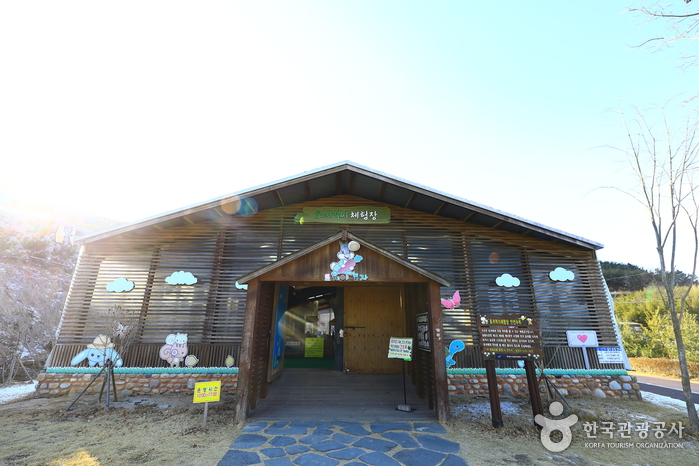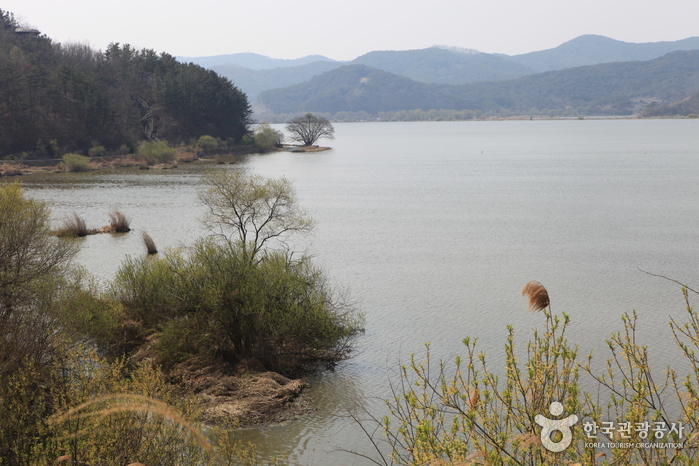Twelve Tablet Pavilion of Hyeonpung Gwak Clan (현풍곽씨십이정려각)
0m 8133 2020-04-14
3, Jidong-gil, Dalseong-gun, Daegu
+82-53-668-3162
Designated as Daegu’s Cultural Property No. 29 on May 12, 1995, Twelve Tablet Pavilion of Hyeonpung Gwak Clan (Jongnyeo-gak of the Hyeonpung Lineage of the Kwak Clan) was built in the mid-Joseon period during King Yeongjo's rule. The pavilion houses 12 Jeongnyeo-gak tablets awarded to the members of the Gwak Clan from the time of King Seonjo in 1598 to the time of King Yeongjo.
It is an important and unique hertiage because the Gwak Clan attained their 12 Jeongnyeo-gak tablats all in one village, which is quite uncommon. During the Joseon dynasty, Jeongnyeo-gak tablets were awarded to honor loyal retainers, devoted sons, and exemplary husbands and wives.
161 Coffee Studio (161스튜디오)
3.0 Km 0 2024-02-15
581, Biseul-ro, Hyeonpung-eup, Dalseong-gun, Daegu
161 Coffee Studio is a spacious bakery café, complete with a terrace and an outdoor grassy yard. It's particularly popular for being kid-friendly, offering various facilities and games for children. In the fall, the café becomes especially picturesque as the yard is adorned with lush pink muhly grass, earning it the nickname "the pink muhly café." The café's menu includes a range of drinks and desserts, with the Salt Coffee (salt cream einspänner) standing out as its signature beverage. Inside, the café's large picture windows provide a panoramic view of the surrounding fields, adding to the overall ambiance.
Wonjo Hyeonpung Park Soseon Halmaejip Gomtang (원조현풍박소선할매집곰탕)
3.4 Km 44884 2024-02-27
56-1 Hyeonpungjungang-ro, Hyeonpung-eup, Dalseong-gun, Daegu
Established in the 1950s as a rural restaurant specializing in doenjang jjigae (soybean paste jjigae), Wonjo Hyeonpung Park Soseon Halmaejip Gomtang gained popularity when the gomtang (beef bone soup), boiled on special occasions, became a signature dish. Ms. Park Soseon started the restaurant under the name "Halmaejip" and has continued the tradition for three generations. Renowned as one of the top three gomtang restaurants in the country, alongside establishments in Haeju and Naju, it proudly represents Daegu and Gyeongbuk. Known for its clear broth and the harmonious combination of various cuts of meat, it has earned a well-deserved reputation for its delicious gomtang.
Daegu National Science Museum (국립대구과학관)
3.9 Km 5602 2023-01-05
20, Techno-daero 6-gil, Dalseong-gun, Daegu
+82-53-670-6114
At Daegu National Science Museum, children can explore the world of science while they play and participate in diverse hands-on activities. Various science programs provide opportunities for children to use their imagination and creativity as they engage in learning.
Daegyeonsa Temple (대견사)
6.3 Km 35246 2024-02-15
232 Hyuyangnim-gil, Yuga-eup, Dalseong-gun, Daegu
Daegyeonsa Temple, with its rich history spanning a thousand years, is situated atop Biseul Mountain, over 1,000 meters above sea level. It is famed for housing the enshrined Buddha's sarira. Encircled by unusual rock formations, the temple appears almost sky-touching. The view from its three-story stone pagoda, perched on the edge of a cliff, is nothing short of breathtaking. Particularly in spring, when the azalea colonies of Biseulsan Mountain are in full bloom, the scenery transforms into something truly magical. Conveniently, the temple can be easily reached by electric vehicle from the Biseulsan Recreational Forest.
Dodongseowon Confucian Academy [UNESCO World Heritage] (도동서원 [유네스코 세계문화유산])
6.4 Km 15217 2023-01-05
726, Gujiseo-ro, Dalseong-gun, Daegu
+82-53-616-6407
Dodongseowon Confucian Academy was first established by Confucian scholars in 1568 at the eastern base of Biseulsan Mountain, but was burnt down during the Imjin War (1592-1598). In 1605, the school was reconstructed on its current site and was renamed Borodongseowon. In 1607, the name was changed to Dongdoseowon. "Dongdo" means that the teachings ("do") of Confucianism come from the East (dong in Korean). Dodongseowon is one of the 47 major Confucian academies that was not affected by Heungseon Daewongun's order to eliminate Confucian academies.
Biseulsan Recreational Forest (비슬산자연휴양림)
7.9 Km 46228 2024-02-07
99 Iryeonseonsa-gil, Yuga-eup, Dalseong-gun, Daegu
+82-53-659-4400
Biseulsan Recreational Forest is located near Daegyeonbong Peak, between Johwabong and Gwanggibong Peaks, and is beautiful all year round. The largest charm of this forest is the ability to enjoy the beautiful scenery in comfort thanks to the amenities. The valley features many uniquely shaped rocks. Every year in late spring, the field near the summit of Biseulsan Mountain blooms with wildflowers. The forest is a popular location for youth retreats during school vacations. Additional facilities include cabins, a campground, pond, and more.
Santokki Park (산토끼 노래동산)
10.7 Km 0 2023-06-27
623 , Ibang-ro, Changnyeong-gun, Gyeongsangnam-do
+82-0507-1352-1401
Santokki Park is a recreational space located behind Ibang Elementary School in Changnyeong-gun. The park was inspired by the children's song "Santokki," meaning mountain rabbit, composed and written by Lee Il-lae who was a staff at Ibang Elementary School. The park comprises a variety of things to do and see related to rabbits, including a rabbit village, rabbit cave, and rabbit feeding experience. There are also spaces dedicated to Lee Il-lae, his work, and small animals. The park is kids-friendly with recreational places where children can freely run around as well as other amenities that help visitors rest and relax.
Yongyeonsa Temple (Daegu) (용연사(대구))
12.2 Km 42255 2024-02-15
260 Yongyeonsa-gil, Okpo-eup, Dalseong-gun, Daegu
The name Yongyeonsa has its roots in a legend: a dragon is said to have ascended from the pond at the temple's entrance, leading to the name Yongyeon ("yong" means "dragon" and "yeon" means "pond" in Korean). This temple is renowned as one of the sites that enshrine the Buddha's sarira (relics). Inside Yongyeonsa, the ordination platform holds special significance as the resting place of the Buddha's sarira, where rituals are conducted. This symbolizes the enduring presence of the Buddha. The approach to Yongyeonsa Temple is through a forest-rich path, offering an experience akin to a forest bathing. This path also doubles as a hiking trail leading up to Biseulsan Mountain.
Changnyeong Upo Wetland (창녕 우포늪)
12.6 Km 40894 2023-02-13
220, Uponeup-gil, Changnyeong-gun, Gyeongsangnam-do
+82-55-530-1533
Upo Wetland is the largest natural wetland in Korea. The wetland takes up three different areas of Changnyeong-gun with a total size of 2,314,060 square meters. Created approximately 140 million years ago, the wetland was formed when the soft ground collapsed and water filled the area to form swamps and lakes, where dinosaurs played. Dinosaur footprints can be found at Sejin-ri near Upo Wetland.



 English
English
 한국어
한국어 日本語
日本語 中文(简体)
中文(简体) Deutsch
Deutsch Français
Français Español
Español Русский
Русский